Beyond war and the Taliban, Afghanistan boasts historical landmarks, a millennial history and a diverse cultural heritage that includes intriguing and delicious national dishes, a few of which it shares with its neighbor to the west, Iran.
Sumaira Akbarzada
As a first generation Afghan American raised in California, the greatest source of pride in my cultural heritage was the traditional food my mother cooked for us growing up. Not only did Afghan food bring my siblings and I much joy, it was our deepest connection to Afghanistan, a country we had only heard stories about from our parents and elders. My family fled after the Soviet invasion and arrived in the U.S. as refugees in the early ‘90s. Having lost everything in a blink of an eye, forced to start over in a foreign land, we tried to stay connected to our roots through language and home cooking; both have played a significant, multidimensional role in shaping our identities as an Afghan family in America.
Our love for our traditional dishes and learning the delicate art of Afghan cuisine helped bridge three generations in my family, my grandmother passing on her culinary skills and knowledge to my mother, and my mother passing it on to my sister and I. The more I learned about the various recipes and culinary techniques from the different regions of Afghanistan, the more I fell in love with my ancestral homeland.
Afghanistan is at the heart of Asia, situated at the crossroads of the Silk Road, connecting the Arab world, Iran and Central Asia to the Indian subcontinent and the Far East. This distinctive geographical location has given the country a rich and diverse heritage of cultural influences and exchanges, which has manifested in its delicious and flavorful cuisine.
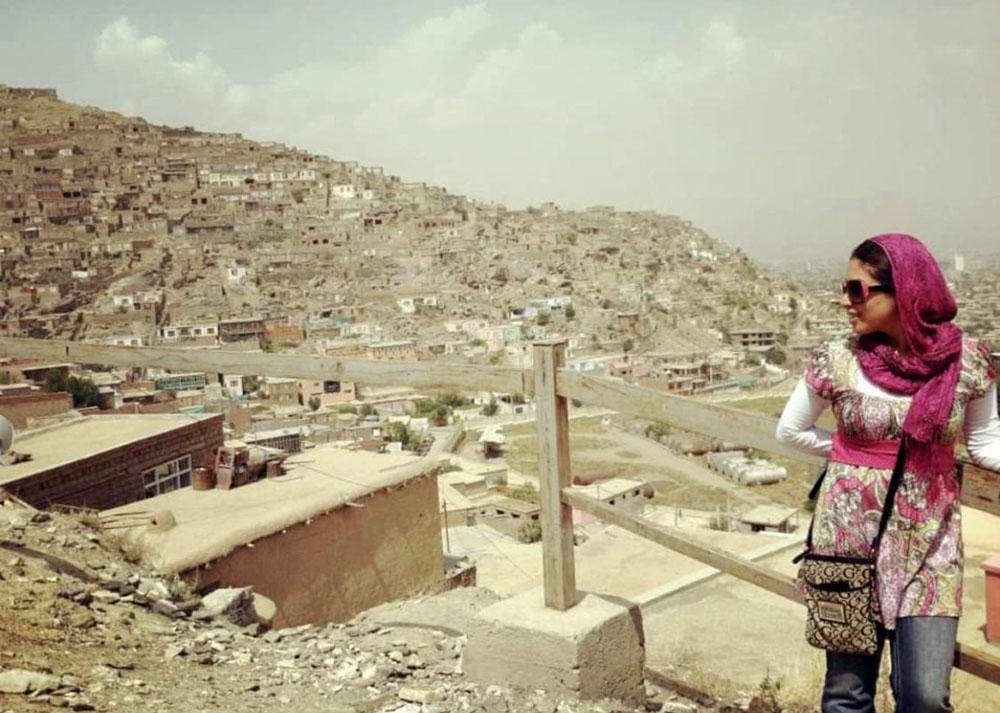
My appreciation for our cuisine further solidified during my first trip to Afghanistan in 2011. I had no idea what to expect when I decided to accompany my uncle and aunt to attend my cousin’s wedding in Kabul. I was both excited and apprehensive of what lay ahead, but it was during this trip that I experienced the beautiful multifariousness of the country and its food.
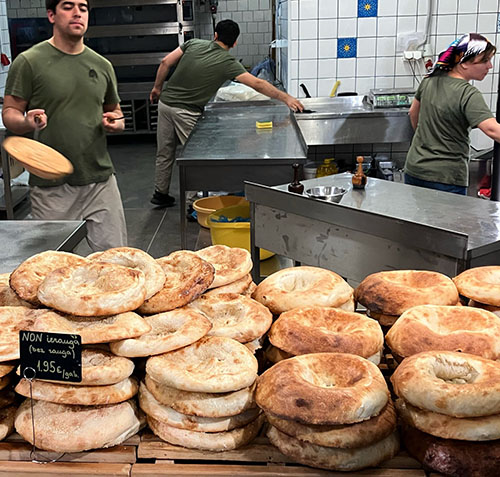
Afghans are well-known for their unmatched hospitality and generosity. From soul satisfying home-cooked meals, to exhilarating street foods, to delectable and tasty dishes served at Afghan weddings, the eclectic cuisine of Afghanistan was a mix of sweet and salty, savory and smokey, sour and spicy. I could confidently say Afghans were quite adept at using spices to blend two completely opposite flavors together and creating an even more tasty combination. Afghan cuisine consists of a variety of elements including rice, meats, stews, lentils, bread, yogurt, onions, fresh herbs, pickled vegetables, salads, and chutneys. The most popular dish that shows up in every meal is rice.
Afghanistan, roughly the size of Texas, is one of the most ethnically diverse nations on the planet. Bordering Iran, Turkmenistan, Uzbekistan, Tajikistan, Pakistan, and China, an enticing culinary fusion took hold at this juncture of civilizations. Afghan cooking blends spices, ingredients and techniques from lands far and near with its own native spices and traditions. Saffron and green cumin are two spices native to Afghanistan. Saffron has been cultivated in the fields of the eastern Afghan city of Herat for centuries, while green cumin known as “siah jeera” is grown in the mountains of the northern province of Badakhshan. Other important spices include turmeric, cardamom, coriander, cinnamon, and black pepper. In addition to flavor, Afghan cuisine emphasizes a deep appreciation for the visual appearance of its colorful and distinct dishes. And none exhibit these characteristics more than the tasty and visually pleasing rice dishes from Afghanistan, especially our national dish, Kabuli Pulao.
Kabuli Pulao: National Dish of Afghanistan
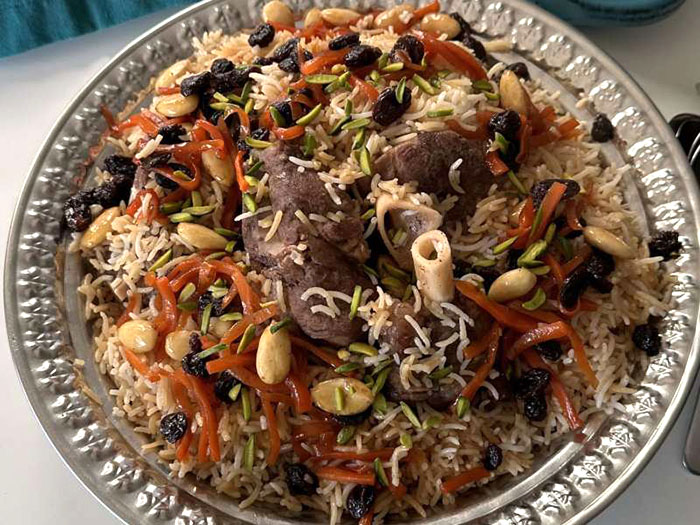
Kabuli Pulao is nothing short of nobility within Afghan cuisine. Translating to “excellent rice” in the Dari (Persian) language, this is a flavorful dish made with long grain basmati rice, lamb, fried onions, caramelized carrots, sweet plump raisins, and garnished with slivered pistachios and almonds. The rice is slowly cooked and steamed in a delectable blend of spices and broth, giving it a rich brown color and fluffy soft texture. The tender lamb pieces are braised and cooked in the simmering broth, allowing all the flavor to seep deep into the meat. The dish requires a fair amount of skill and technique to prepare, and results in an amazing bold and vivid flavor once all the components are all brought together. Kabuli Pulao is served at weddings and celebrations in Afghanistan. Varieties of this dish exist throughout the various regions of the Silk Road, including Uzbekistan, Tajikistan, and within Uyghur cuisine in occupied Turkmenistan in eastern China. You can find the full recipe to this succulent dish here: Kabuli Pulao.
Outside Kabul, my favorite city was Mazar-i-Sharif, a city on the Silk Road that served as a major trading hub in northern Afghanistan. The name Mazar-i-Sharif translates to “tomb of the saint,” the tomb referring to the Blue Mosque, which the city is famous for, built by the Turkic Seljuq Dynasty. Due to this Turkic influence, in addition to the city’s proximity to both Uzbekistan and Turkmenistan, the cuisine of Mazar-i-Sharif incorporates Turkic flavors with the city’s Afghan and Persian influences. The first dish I had in Mazar that illustrated this blend of aromas was Shor Nakhod, a spicy chickpea and potato appetizer dish served with cilantro chutney and red chili sauce. (You won’t find intense or overpoweringly spicy dishes in Afghan cuisine. The use of chilis is moderate, neither as spicy as Indian cuisine, nor as mild as in Persian cooking, but somewhere in between.) In addition, Mazar had some of the best street kabobs I had in all of Afghanistan, fragrant and succulent cuts of chicken and beef threaded individually on metal skewers. Mazar is also famous for its traditional Uzbek bread, which is versatile and tastes great with almost any Afghan dish, including kabobs, stews, soups, salads, and chutneys.
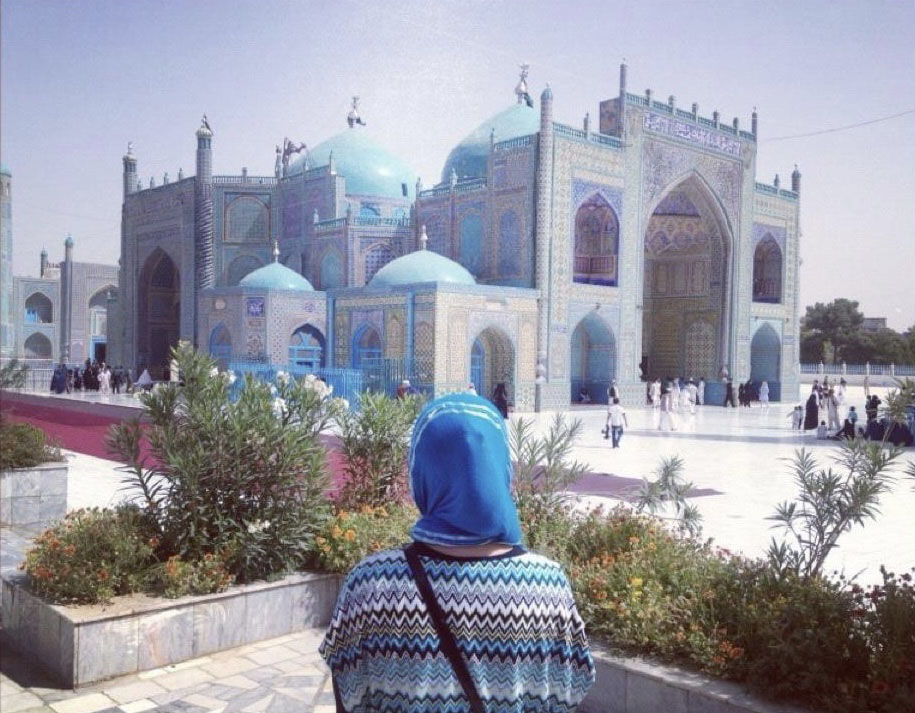
Zamarod Pulao
Mazar-i-Sharif serves as the capital of the ancient province of Balkh. Balkh is the birthplace of the beloved Persian poet Rumi and where the Persian New Year, Nowruz, originated. Nowruz is a national holiday in Afghanistan predating back to the ancient religion, Zoroastrianism. And one of the main dishes served during Nowruz is Zamarod Pulao.
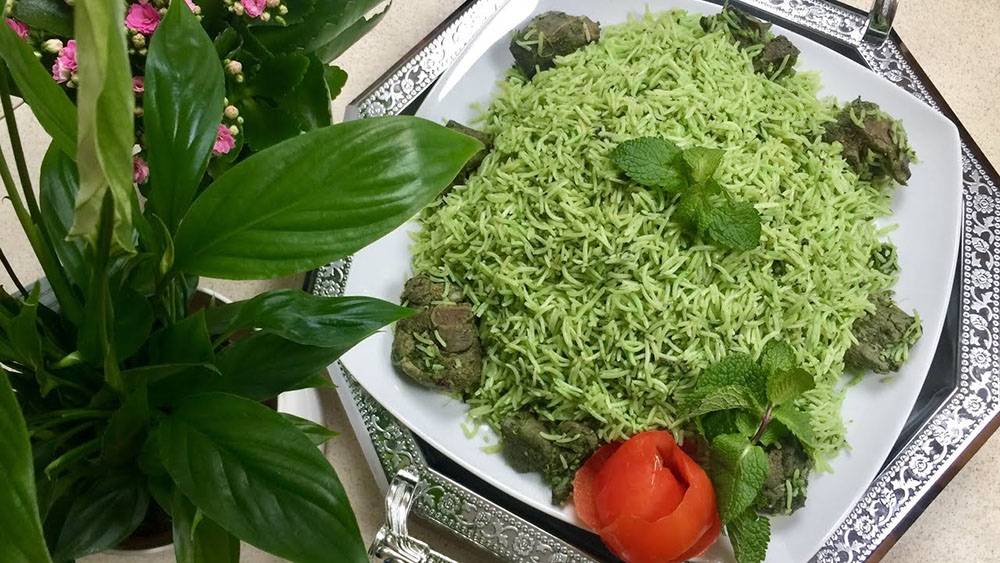
Zamarod Pulao, which translates to “emerald rice” in Dari, is a delightfully elegant rice dish prepared with fresh spinach and slowly cooked in a beef stock. The spinach gives the rice its signature green color and is why it is named after the precious green gemstone. In addition to spinach, other fresh herbs that can be incorporated into the dish include parsley, dill, cilantro, chives, and fenugreek. Beyond Nowruz, this hearty dish is served on a number of special occasions. You can find the full recipe here: Zamarod Pulao.
Narenj Pulao
Narenj Pulao is a fragrant and delicate rice dish prepared with the citrus peels of oranges. In Afghanistan, the citrus peels come from the Seville orange, called narenj in Dari, from the Spanish naranja. These fruits are a cross between oranges and lemons, giving them both a sour and bitter taste. If the narenj is not readily available, then the peels of a regular orange can be substituted. The peels are sun-dried and blanched to get rid of the bitterness, then candied in sugar syrup. In addition to the sweetened citrus peels, the dish is flavored with cardamom, cumin, and saffron and prepared with lamb or beef. This dish is generally prepared for very special occasions and celebrations because of how time-consuming it can be to prepare the delicate ingredients. You can find the full recipe to this citrus dish here: Narenj Pulao.
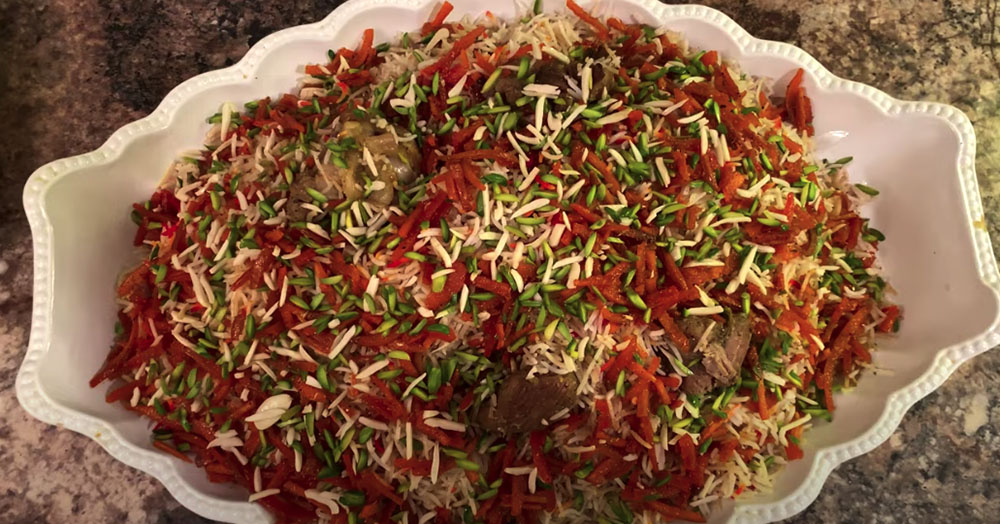
Zereshk Pulao
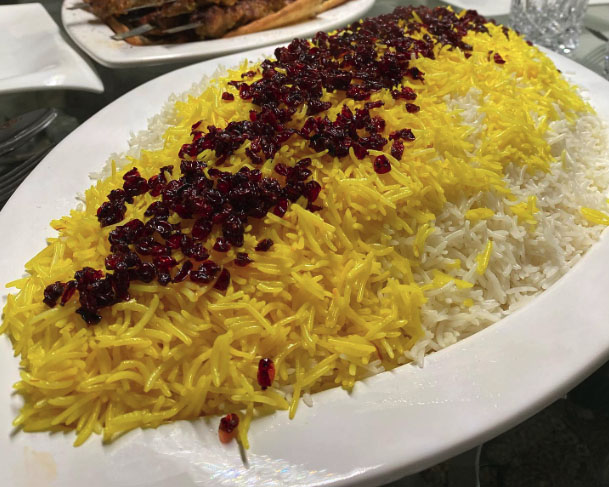
Zereshk Pulao is a sweet and sour rice dish Afghanistan shares with its neighbor, Iran. The dish is prepared with wild, tart barberries called “zereshk” in Dari and Farsi. There are a variety of barberry species in different regions of the world. The barberries are caramelized in sugar syrup, giving them a sweet kick. The rice is then slowly cooked in a creamy succulent broth made with butter, saffron, turmeric, tomato paste, fresh squeezed lemon juice, and fork-tender chicken thighs. This festive and opulent dish is perfect for any family gathering or holiday celebration. You can find the full recipe to this succulent dish here: Zereshk Pulao.
Mash Pulao
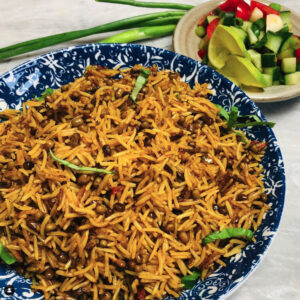
Mash Pulao is a traditional Afghan dish prepared with long-grain rice, mung beans, and a mix of fragrant spices. The rice is prepared with a combination of sautéed onions, tomatoes, ginger, garlic, and peppers. This opulent mixture is then slowly simmered over low heat in a flavorful stock containing turmeric, cumin, coriander, cinnamon, and a masala blend. The final dish is served with homemade yogurt, fresh salad, or cilantro chutney. You can find the full recipe to this comfort dish here: Mash Pulao.
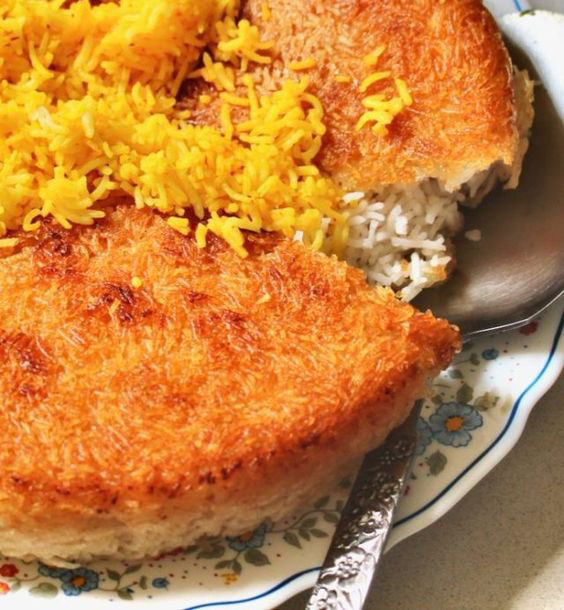
Another favorite rice dish Afghans share with their Iranian counterparts is the golden and caramelized dish called tahdig. Tahdig translates to “bottom of the pan” in Dari and Farsi. Basmati rice is infused with saffron, salt, turmeric, and butter, and cooked directly over the flame to form the crunchy and crispy crust at the bottom of the pot. While the rice is cooking over the flame, a kitchen towel is wrapped around the lid to prevent any moisture from returning to the pot and hence allowing the bottom of the rice to become golden brown. This dish is just irresistible and hard to turn down and often the most prized part of any and all Afghan rice dishes. You can find the full recipe to this crunchy goodness here: Tahdig.
Sheer Birinj
Sheer Birinj is a creamy and luscious rice pudding dish popular in Afghanistan, Central Asia, the Indian subcontinent, and throughout the Middle East. The main ingredients include short-grain basmati rice, sugar, unsalted butter, rose water, whole milk, cardamom, and cinnamon. In contrast to traditional rice puddings, sheer birinj has a much thicker consistency and texture and is cooked in a slow and time-consuming process. The high fat content from the whole milk ensures a rich finish. You can find the full recipe to this creamy goodness here: Sheer Birinj.
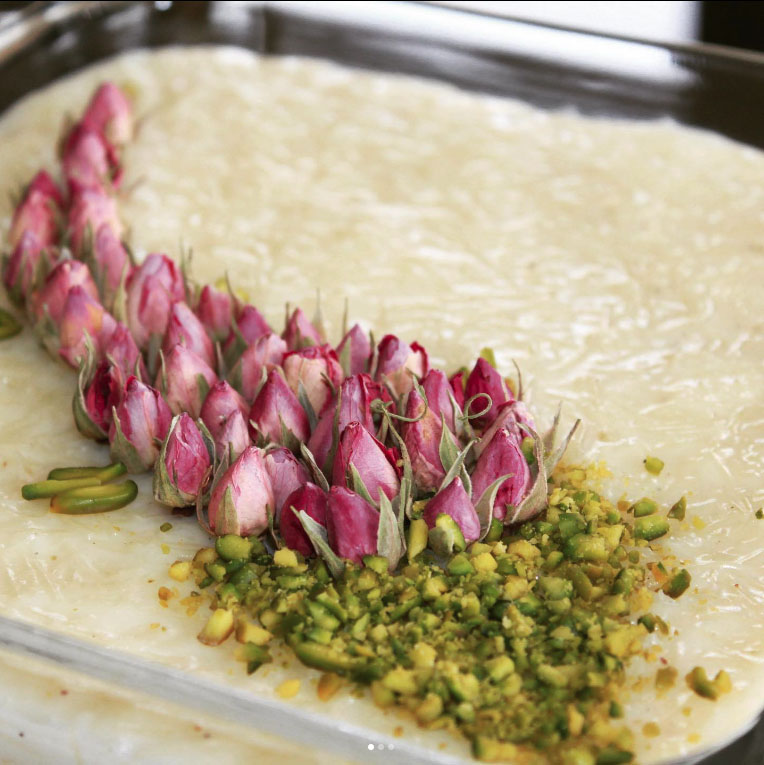
Rice is a vital part of Afghan cuisine as it is consumed in all regions of Afghanistan as well as throughout the Afghan diaspora in the west. Our culinary traditions have been passed down for generations and I hope to pass them on to my children. Afghan food also serves as a beautiful reminder that Afghanistan is more than what is presented in the mainstream media. And with hopes of conveying a different image of Afghanistan to the west, many Afghan chefs and food experts have been doing a stellar job introducing Afghan cuisine to their western neighbors and communities.
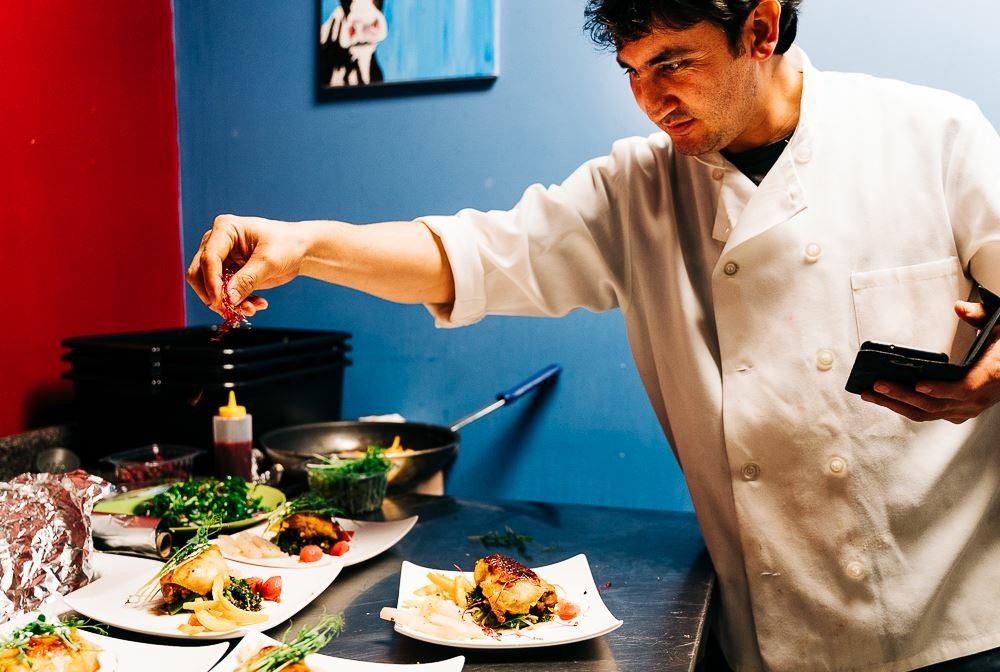
The most renowned Afghan chef in the US is Hamidullah Noori. Chef Noori heads the popular restaurant in Virginia called The Mantu, which opened in 2019. Virginia is home to one of the largest Afghan American communities in all of North America. The Mantu is a chic and elegant fine dining spot that combines the traditional flavors of Afghan cuisine with modern style and infusion.

Another respected Afghan cuisine expert in the US is Humaira Ghilzai. She runs the popular food blog, Afghan Culture Unveiled, where she shares all her favorite Afghan dishes and recipes. Individuals like Chef Noori and Humaira Ghilzai come from diverse ethnic backgrounds with one thing in common, their uncompromised love for Afghan cuisine and sharing it with the world. Afghan cuisine embodies kindness and love for family and friends as well as one’s proud heritage. It holds an essential key to the history of Afghanistan and reflects the diversity of the Afghan people. Afghan cuisine, and especially Afghan rice, is the soul of our country and high on the list of delectables of the Silk Road.



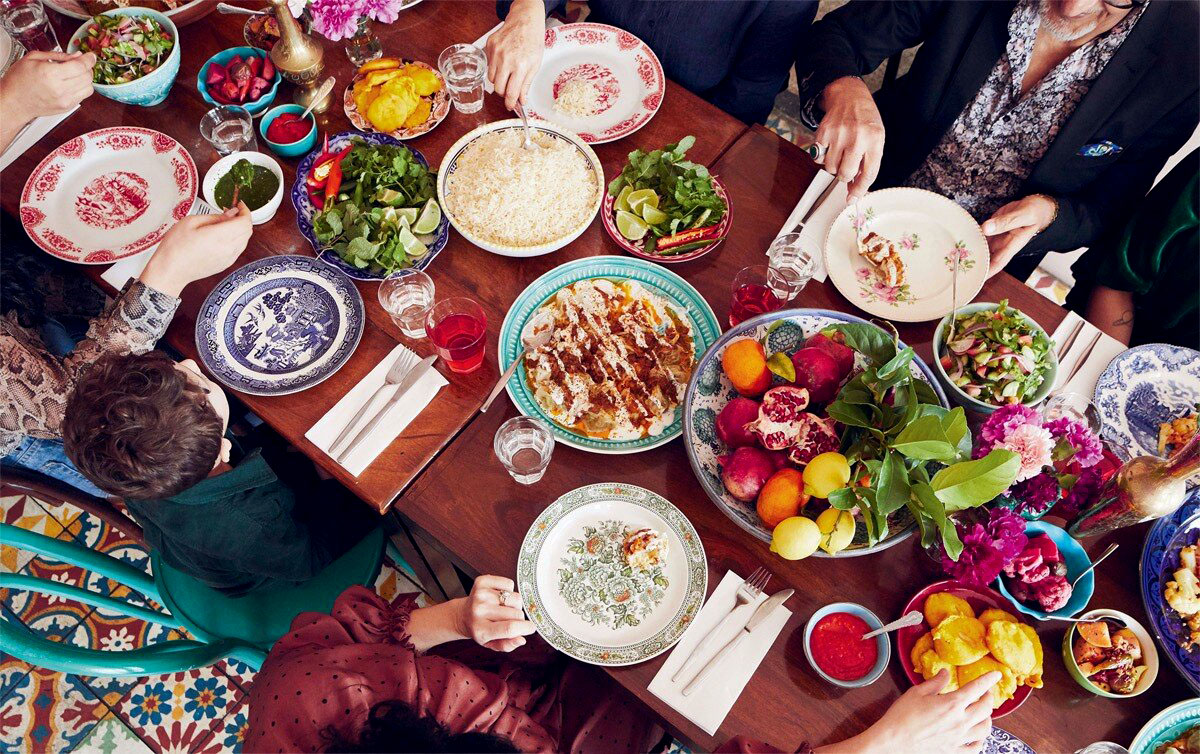

Thank you Sumaira for sharing your experience of Afghanistan and sharing some delicious rice recipes.
Always good to see serious engagements of material culture as in this article. Eastern food cultures are not only sophisticated–they are part of mature and refined cultural traditions. Two points in this fine piece are worthy of further considerations: Reflecting a good image of culture through food shouldn’t be a real concern. The west has been dominant economically and militarily, but is it prepared to make objective cultural judgements? The second is the necessity of comparative perspectives in presenting material cultures. The region’s cuisines benefited from each other, and it makes sense to take comparative approaches in discussing them.